A FEW WORDS WITH BFS CLINICIAN RICK BOJAKRick Bojakís legacy of success is more about peace of mind than a bigger piece of the pie.By Kim Goss Published: Fall 2001 Many of us assume that those who spend countless hours studying to achieve higher-level academic degrees will naturally seek out the highest-paying professions. Others, such as Rick Bojak, believe that there are treasures in life more valuable than a big paycheck. Rick was an exceptional athlete who played middle linebacker and running back in college and was inducted into the Northwest Athletic Association Hall of Fame. After graduating with two master degrees from the University of Utah, one in psychology and the other in physical education, Rick went on to achieve his dual goals of becoming a respected educator and coach. He coached football at three universities, and has earned a reputation for being able to turn losing programs into winning programs. In the case of Jordan High School, he took a team with a 0-22 record to the 4A state finals in just one year. As an educator, Rick was named 1995 Utah State Teacher of the Year, an award that earned him a trip to the Oval Office and congratulations from the president of the United States. Rick has been a firm believer in the BFS program since his first days as a coach. His enthusiasm led him to become a BFS clinician in 1995, and the first clinic he co-taught with BFS President Dr. Greg Shepard in Washington resulted in several state championships for the school. The positive results of his clinics have been documented in the BFS Journal on numerous occasions. For example, in the Spring 2000 issue you can read inspiration stories about how Rickís BFS clinics helped turn around football programs for the New Albany Eagles in Ohio and the Concordia Panthers in Kansas. A family man with his wife, Janet, and daughter, Jennifer, Rick is currently a teacher and coach at Riverton High School in Utah. BFS is proud to have Rick Bojak as one of its spokespersons, and in this interview Rick gives us his personal perspectives on connecting with kids through BFS. First, the big question: Youíve coached at three universities. Why did you switch to coaching at the high school level? If youíre a head coach at a university youíll certainly make a lot of money, but I found that to coach at that level you donít have a life. Itís a seven-day-a-week job, 365 days a year, and during the football season youíre looking at 16-hour days. I certainly respect those who do it, but they donít have time to do anything else, and lifeís too short to live that way. Plus, when I was coaching at that level I wasnít teaching, and I like the classroom because thatís where youíre molding the kids, making a difference in their lives. Itís where the great things happen. With college kids, they have their lives already planned - you can help a little bit, but the rewards are not the same as you get with high school. How did you first learn about BFS? I go way back to the early 70s when Greg Shepard and I were football coaches, sometimes coaching against each other. Greg was always involved in a lot of powerlifting meets; I knew some of the things Greg was doing with weight training, so I was interested in his program back then. When did you start using BFS with your athletes? Iíve been doing BFS with my teams for the past 25 years, but particularly in the last ten, which is the time I really noticed the biggest improvements. When we really got to the nitty-gritty - doing the BFS program as perfectly as possible - thatís when it really made a difference. Many coaches will say youíve got to have the special Xís and Oís, but none of this makes a bit of difference unless you have the athletes. You need to work on their bodies to get them big, fast and strong. If youíve got big, fast and strong kids who want to win, you can win anything no matter what offense or defense youíre running. What do you remember most about your first year as a BFS clinician? After a clinic was over, I was so pumped and so excited that when it ended that day at 4:00, I just wanted to go to sleep - I was just dead tired. The clinics are very energizing and they take everything out of you. Now, I still get excited, but Iím not quite as tired afterwards. How many BFS clinics have you given? You first have to understand that August through November I seldom do any clinics because of football. During the rest of the year I try to get in one every third week. So, over the last six years, weíre talking about 80 clinics. Why do you still feel so enthusiastic about running BFS clinics? For one thing, I still feel that Iím a rookie because Iím only six years into it. But then, as a teacher Iím in my twenty-sixth year, and I still get excited every day getting up and going to work! Would you share with us a favorite clinic experience? Iím always talking about keeping your eye on your target. I gave a clinic to a team in Flambeau, Wisconsin. They were 3-6, and after the BFS clinic they went on to the championships. The next year when I came in again, one of the boys who had been at that earlier clinic told me, ďYou know, Coach, Iíve got to tell you about that Ďeye on the targetí thing. When we went for that State championship game we took our helmets off, and the other team didnít. We just kept staring right at them, but they wouldnít look back - theyíd look down, look up, and back down again. After the coin toss we said, ĎWeíre going to kick their butts because they couldnít even look us in the eye they were so scared.Ē Whatís the best aspect of the BFS program - what sets it apart? Itís the emphasis on record keeping, because it makes it so much fun for the kids to see themselves getting better. How has your coaching staff and your school responded to the BFS program? Most of my staff has either played for me or coached with me, going as far back as the early Ď80s. Theyíve known about BFS for a long time, and theyíre into all of it. And our whole school is involved with BFS - itís part of the curriculum. How does your school implement the BFS program in the curriculum? The coaches teach the BFS program and they use the videos. Itís like putting on a clinic, but you only have an hour. A clinic lasts eight hours, so it takes about eight class periods to teach everything and teach it correctly. They donít lift for about two weeks. The kids are so antsy after that they just canít wait to get going. How big is your weight room? We have two weight rooms-one is 40 x 70, and the other is 30 x 50. Why do you have two weight rooms? We needed more weightlifting classes because the kids wanted it. Having a class every day in one room wasnít enough, so the principal, the vice-principal and I made another weight room. We called BFS and bought four more squat racks and five more benches, and platforms and dumbbells and a hip sled. We bought all of it just for the new room and now we get about 300 kids going through the program every day. What has been the effect of the BFS program at Riverton High School in regard to athletic performance? Last year we made the state playoffs in football, which we felt great about because we only started seven seniors. The first year we had only about one month of lifting because the school had just opened up, so we were very weak. Now that weíve had a full two years, weíre looking great and weíre excited about the upcoming season. How about the womenís sports? Our womenís sports are doing great. Our volleyball team won the regions, and theyíre on the BFS program. You have a masterís degree in psychology. Do you find that the skills you learned in that field have helped you become a better coach? Absolutely. Anybody who deals with the mind and behavior is always going to be talking about goal setting. Doing things for the future, doing things to get ready for the future. Thatís why our workout card is so valuable. Every day the kids come |
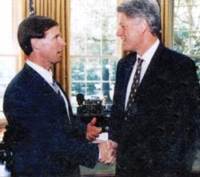 |
|
Coach Rick Bojak and President Bill Clinton |
 |
|
Rickís Family: (L to R) Janet, Matt (son-in-law) Rick, & Jennifer |
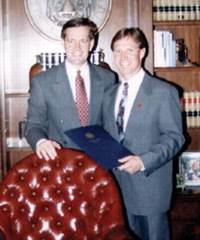 |
|
Coach Bojak with Utah Governor Mike Leavitt |
 |
|
Coach Bojak and his Riverton High Silverwolves actively pursue another victory. |
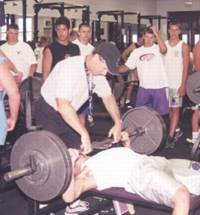 |
|
Coach spotting Brady Bowen on the Bench. |
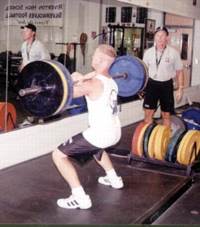 |
|
At only 170 lbs. Rex Jolley Cleans 225 lbs. |
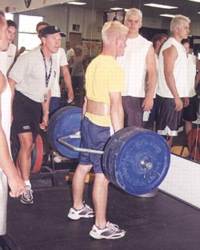 |
|
Gavin Collier doing 405 lbs. five times. |
 |
|
6í0-255 lb freshman Spencer Bowles lifts 335. |
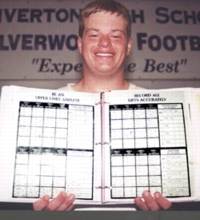 |
|
Matt Bland showing his daily BFS Record Card. |
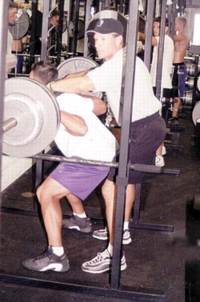 |
|
Coach Bojak with QB Matt Edwards in the Squat. |